Stevington schoolmaster Harry Read sent duplicated newsletters to his "gallant lads", former pupils at the school, at the front in the First World War. The letters contained both home front news and that from the lads themselves. Bedfordshire and Luton Archives and Records Service has an incomplete series of these dating from May 1916 to August 1918 - letters eleven, fifteen, sixteen, nineteen, twenty, twenty two, twenty four, twenty five and twenty six [P71/28/21/11-26]. From these and the Saint Albans Diocesan Roll of Honour the following men who killed can be identified. In 2000 the Stevington Historical Trust compiled an admirable volume entitled
Stevington:The Village History which added the name of Seamarks to the list.
For those men killed with the Bedfordshire Regiment it is possible to use the battalion war diaries, held by Bedfordshire and Luton Archives and Records Service, to determine what they were doing when they were killed. For those killed with other units more general information has been used for this purpose.
![Bill Allen [P71/28/13/1]](/CommunityHistories/Stevington/StevingtonImages/Bill Allen P71-28-13-1_181x300.jpg)
Bill Allen [P71/28/13/1]
ALLEN, 17668, Private William Charles: A Company, 2nd Battalion, Bedfordshire Regiment. He was known as "Guts" and volunteered in November 1914, going to France in June the following year. He was killed on 1st October) 1915, aged 20 and is commemorated on the Loos Memorial. He was the son of Thomas and Annie Elizabeth Allen of Silver Street.
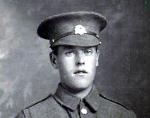
Bill Allen close-up
Poor Guts was killed in the last action of the Battle of Loos in which the battalion took part. It had been involved in operations since 25th September, the first day of the battle, and 1st October was the day they were relieved. They had attacked German positions just on the outskirts of the Town of Hulluch, advancing from the town of Vermelles. They had taken the front line trench but suffered casualties moving in the open towards the German second line, which they eventually took, only to be ejected by a counter-attack around midnight. They launched their own counter-attack and retook the lost trench. Next day they were relieved and went back to the old German front line trench in support and finding working parties. This situation carried on until 29th September when they moved back into the front line. The Germans launched an attack on 30th, forcing the battalion to give way then regrouped and, just after midnight, launched a counter-attack along a trench called Stone Alley, which was only partially successful. The men fell back and blocked the trench. It was likely in this action that Guts Allen was killed, presumably his body lay beyond the block as it was never recovered, thus he was commemorated on the Loos Memorial to the Missing. Later that day the Bedfords were relieved and marched back to barracks at le Quesnoy. In the seven days operations 40 men were killed and 40 declared as missing; 270 were wounded.
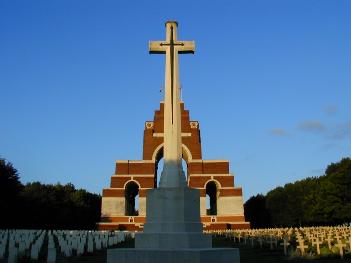
The Thiepval Memorial
ASPLEY, 12797, Lance Corporal Henry George: 7th Battalion, Bedfordshire Regiment. He landed in France with the Battalion in July 1915 and served as a bomb, or grenade, thrower. In trench warfare grenades were very important for flushing out, or stopping the attacks of, an enemy one could not see. Thus men with the most powerful and accurate throws were in demand as specialist grenadiers. Aspley was killed on 8th January 1916, aged 20 and commemorated on the Thiepval Memorial. He was the son of Alfred and Martha Aspley, of Silver Street. The 7th Bedfords were on the Somme which, at that time, prior to the offensive begun on 1st July that year, was a quiet sector. The battalion was on a stint in the front lines near Fricourt from 31st December to 8th January. The only suggestion as to how Aspley died is that the war diary notes: "At 7.30 a.m. in response to our rifle grenades the enemy shelled Battalion H.Q. and Watling Street [the name of a trench]quite heavily for about 10 minutes. They were silenced by our Guns and trench Mortars. Several of enemy's shells fell also either side of Old Kent Road and between Maple Redoubt and 71 South". One can only guess that one of these shells killed poor Aspley and that his body was destroyed by the blast, hence the fact that he has no grave and is commemorated on the Thiepval Memorial.
 Division badge.gif)
15th (Scottish) Division badge
CHURCH, 131421, Private Thomas: 15th Battalion, Machine Gun Corps. He died of wounds on 23rd September 1918, aged 19 and is buried at Houchin British Cemetery near Béthune. He was the son of Ada J. Church, of Park End. The Machine Gun Corps. In 1914, all infantry battalions were equipped with a machine gun section of two guns, which was increased to four in February 1915. The British were much slower than the Germans to appreciate the usefulness of the weapon but by the end of 1914 it had become apparent that the weapon required special tactics and an organisation outside that of the infantry battalions. The Machine Gun Corps was formed in October 1915. The 15th Machine Gun Corps, from March 1918, was attached to 15th (Scottish) Infantry Division. This division had been in action on the River Marne at the end of July and beginning of August. It seems likely that Church received his wounds further north, somewhere near the place he died, and somewhat closer to the date of his death. He was probably hit by shell splinters or shot by a sniper whilst serving in or near the front line - part of what is referred to, rather unfeelingly, as daily wastage.
![Good attendance medal for Albert Cowley [E/PM4/3/2]](/CommunityHistories/Stevington/StevingtonImages/Good attendance medal for Albert Cowley [E-PM4-3-2_182x300.jpg)
Good attendance medal for Albert Cowley [E/PM4/3/2]
COWLEY, 76977, Private Albert William: 9th Battalion, Royal Fusiliers. He was killed on 14th May 1918, aged 18 and is commemorated on the Pozières Memorial. He was the son of Jesse William and Mirriam Elizabeth Cowley, of The Post Office, then at 3 Church Road, Stevington. 9th Royal Fusiliers formed part of 12th (Eastern) Division. The division was in the Auchonvillers area on the Somme from April to June 1918, a time without a major engagement. It seems likely that Cowley was either hit by a shell and his body destroyed or, perhaps, that he was lost while on patrol or a raid in no man's land. At any rate his body was never found and so he is commemorated on the Pozières Memorial to the Missing. Bedfordshire and Luton Archives and Records Service has a good attendance medal of his from his time at Stevington School [E/PM4/32].
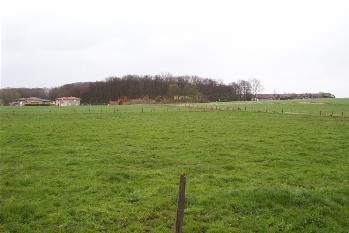
The Ypres battlefield near Hill 60
COX, 8589, Acting Lance Corporal Alfred Andy: 1st Battalion, Bedfordshire Regiment. He died of wounds on 22nd April 1915, aged 31 and is buried at Boulogne Eastern Cemetery. He was the son of Alfred and Elizabeth Cox, of 67 Woburn Road, Kempston, Bedford, though a native of Stevington, Bedford. Cox's quite low serial number, his address in Kempston and his early date of death in a regular battalion all suggest that he had joined up before the war started. The battalion was at Ypres in April 1915 and the fact that Cox died well behind the lines, at Boulogne, suggests that his wound was a serious one. The battalion was in the front line from 12th to 21st and on 18th the Germans seized part of the strategically important Hill 60 from the 13th Brigade of 5th Division (the Bedfords were in 15th Brigade). At six o'clock that evening the battalion counter-attacked the Germans on Hill 60 and drove them off. Considerable shelling of the newly regained position took place all next day and attacked the hill again on 20th April. The war diary reads: "tremendous bombardment carried out against Hill 60, & our trenches & supports. Enemy's heavy guns enfiladed position, other guns firing from various directions: bombardment all night". On 21st the diary records: "Bombardment & counter attacks continued during early morning & position critical at times. Casualties very heavy. Enemy's machine guns partially enfiladed reverse of Hill 60, trench mortar bombarded it, & field guns were brought up to within about 30 yards & fired point blank at parapet, blowing it to pieces & mangling the defenders. Our artillery unable to compete with enemy's heavy guns, or to locate small guns which were too close to Hill 60 to be easily shelled. Casualties of Bedfords: 4 officers killed, 8 wounded. Other ranks over four hundred. Cameron Highlanders & 1st Devons arrived during morning & relieved East Surreys & Bedfords who went into reserve at RENINGHELST for sleep & rest". It seems statistically most likely that Cox was one of the four hundred other ranks who became casualties on this day and died of his wounds, most likely inflicted by artillery, two days later.
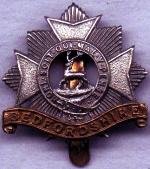
Bedfordshire Regiment cap badge
COX, 17688 Private Edwin: 4th Battalion Bedfordshire Regiment. He volunteered in October 1914 and moved to France in July 1915. This was, presumably with another regiment as 4th Bedfords did not arrive until July 1916. It is known that he was formerly in the Labour Corps, but this was not formed until January 1917. He was invalided home through sickness but returned to the front and was reported missing and presumed killed in action on 27th March 1918 aged 27. He is commemorated on the Arras Memorial. He was the son of the late Joseph and Susan Cox, of Stevington and husband of Rose. She had been born a Pallant and soon after Cox's death remarried, as so many women did, presumably to ensure financial security for themselves, becoming a Seamarks. She lived at Court Lane. On 21st March 1918 the Germans began a huge assault on the weak British 5th Army, quickly overwhelmed it and drove it back. The army was weakened by a refusal of Lloyd-George's government to send reinforcements to France after the bloodbaths of 1916 on the Somme and 1917 at Ypres and Cambrai. Thus divisions had to be reduced by 25% from twelve to nine battalions. In addition the French army was in a poor state and the British were forced to take over more of the front line, thus less men had to cover a wider area. The 4th Bedfords were part of a unique formation, 63rd (Royal Naval) Division. Two of the three brigades of the division were made up of naval personnel, including Royal Marines, who were surplus to requirements in the Royal Navy. The third brigade, including the Bedfords, was made up of army battalions, as usual. On the first day of the German attack the Bedfords were in second line defences near Ribecourt-la-Tour. These defences were, very likely, no more than lines on the map, a few shallow trenches and a few strands of barbed wire as the planned defences in this sector were mostly not yet built. The next days saw constant withdrawal under German pressure but on 27th the Bedfords counter-attacked. The ever laconic war diary (easily the briefest and worst of those held by Bedfordshire and Luton Archives and Records Service) simply states: "Batt [alion] was moved south to a position W of ALBERT where they attacked the Railway at 7.30 a.m. Lt. Col. J. S. COLLINGS-WELLS, D. S. O. MAJOR G. P. NUNNELEY, 2/Lt. D .H. MACKLIN, 2.Lt. O. J. SOAMES killed, Lts. C. KEITH-JOHNSTON M. C. J. B. PRIMROSE-WELLS. 2.Lts. L. HAMBLING & W. BROUGHTON wounded. Capt. L. G. PLUMBLY M. C. took over command of the Batt. temporarily from this date". For his conduct during the retreat and in this action the commanding officer, John Stanhope Collings-Wells, won a posthumous Victoria Cross. Edwin Cox clearly died either in the attack or shortly after it, whilst in German hands as he was recorded as missing. He has no known grave and so is commemorated on the Arras Memorial to the Missing. The citation for Collings-Wells' V. C. reads: "For most conspicuous bravery, skilful leading and handling of his battalion in very critical situations during a withdrawal. When the rear guard was almost surrounded and in great danger of being captured, Lieutenant-Colonel Collings-Wells, realising the situation, called for volunteers to remain behind and hold up the enemy whilst the remainder of the rearguard withdrew and, with his small body of volunteers held them up for over one and a half hours until they had expended every round of ammunition. During this time he moved freely amongst his men, guiding them and encouraging them and, by his great courage, undoubtedly saved the situation. On a subsequent occasion, when his battalion was ordered to carry out a counter -attack, he showed the greatest bravery. Knowing that his men were extremely tired after six days fighting, he placed himself in front and led the attack and, even when twice wounded, refused to leave them, but continued to lead and encourage his men until he was killed at the moment of gaining their objective. The successful results of the operation were, without doubt, due to the undaunted courage exhibited by this officer".
![Ernest Walter Cox [P71/28/13/9]](/CommunityHistories/Stevington/StevingtonImages/Ernest Walter Cox [P71-28-13-9].jpg)
Ernest Walter Cox [P71/28/13/9]
COX, 10516, Lance Corporal 10516 Ernest Walter: 6th Battalion, Bedfordshire Regiment. Known as "Butt", he volunteered in August 1914 and moved to France in July 1915. He was killed in action on 14th February 1917 and is buried at MarocBritishCemetery, 10 miles south-east of Béthune. He was the son of Walter and Ada Cox, of Church Road. The 6th Bedfords were part of 37th Division.
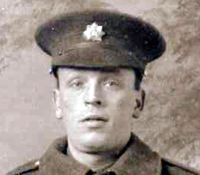
Ernest Cox close-up
Sadly the war diary for February 1917 is skimpy and incomplete. An entry for 11th states: " Marched to LES BREBIS" and for 17th " Front line trenches LOOS (2 Offrs arrived)". Between those two entries is nothing. The battalion does not seem to have been in the front line at the time. One can only assume that he was struck by a shell either behind the lines or when he was in a working party at, or close to, the front.
 Division Badge.png)
18th (Eastern) Division Badge
GARLICK, 42946 Private James Robert: 10th Battalion, Essex Regiment. He had been born in Turvey but was a resident of Stevington. He was killed in action on 26th April 1918 and is commemorated on the Pozières Memorial. The 10th Essex were part of 53rd Brigade, 18th (Eastern) Division - 7th Bedfords were in 54th Brigade of the same division. He had previously been in the Bedfordshire Regiment, the change of unit suggesting he was returned wounded to England and later returned to the front as this was frequently the reason for a change of regiment. As noted under the entry for Edwin Cox above, the German attack of 21st march 1918 made massive headway against weakened British defences. At the start of the attack 18th Division were just outside Saint-Quentin. By the time Private Garlick died they were just east of Amiens, where a small action fought by a provisional battalion made up of 7th Bedfords and 7th Royal West Kents finally halted the German advance near a village called Cachy. On 26th April the 7th Bedfords were resting after this successful counter-attack. The 10th Essex, as part of the same division, must have been somewhere nearby and it seems likely that they relieved the Bedfords and Royal West Kents in the front line and this is where James Garlick lost his life.
![Charles James Goldsmith [P71/28/13/14]](/CommunityHistories/Stevington/StevingtonImages/Charles James Goldsmith [P71-28-13-14].jpg)
Charles James Goldsmith [P71/28/13/14]
GOLDSMITH, 18825, Private Charles James: 1st Battalion, Bedfordshire Regiment. He was known as "Scuttle". He volunteered in January 1915 and was posted to the front in November. He was killed in action on 27th July 1916 during the Battle of the Somme and is commemorated on the Thiepval Memorial. He was the son of Mr. W. Goldsmith and the husband of Caroline Emily Goldsmith of Silver Street.
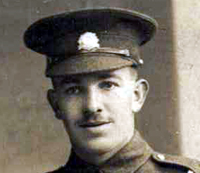
Charles Goldsmith close-up
The 27th July was the date the battalion, part of 5th Division, attacked Delville Wood and Longueval. They assembled in the recently captured German second line trenches at 3.50 a.m. and reached the reserve trenches at 7 a.m. They were acting as battalion in brigade reserve, to be called on if needed. They got the call forty minutes later that the 1st Norfolks were in trouble and needed their help. A and B companies thus helped the Norfolks to assault the second line of the objective at 9 a.m. They took a hundred prisoners nearly at once and a further thirty two when attacking a nearby house in Longueval. C Company went into action at 9.05. Meanwhile A Company fought off a German counterattack at the Flers road. The ground taken was then consolidated by B and D Companies. Next day the battalion withdrew to Pommiers Redoubt between Mametz and Montauban-de-Picardie, which had been taken by the 7th Bedfords on 1st July. Next day the Brigadier wrote: " The Brigadier-General Commanding wishes to express to all ranks of the Brigade his great admiration at the magnificent manner in which they captured the Village of LONGUEVAL yesterday. To the 1st NORFOLK Regiment and the 1st BEDFORDSHIRE Regiment and some of the 16th ROYAL WARWICKSHIRE Regiment, who were able to get into the enemy with the bayonet, he offers his heartiest congratulations. He knows it is what they have been waiting and wishing for for many months". Scuttle was evidently killed somewhere in or near Longueval and his body was never found, hence he is commemorated on the nearby Thiepval Memorial.
![Oliver Francis Harpin [P71/28/13/19]](/CommunityHistories/Stevington/StevingtonImages/Oliver Francis Harpin [P71-28-13-19].jpg)
Oliver Francis Harpin [P71/28/13/19]
HARPIN, 17697, Corporal Oliver Francis: 8th Battalion, Bedfordshire Regiment: he was known as "Dulcie" and was killed in action on 18th April 1917, aged 24, and is commemorated on the Loos Memorial. He was the son of Walter James Harpin, of Silver Street. His wife, Alice Emma, like Edwin Cox's, soon remarried, becoming at Sutton.
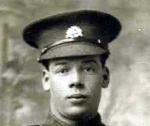
Oliver Harpin close-up
The 8th Bedfords were part of 6th Division and on 18th April 1917 they were in front line trenches between Grenay and Vermelles, near Loos. On 15th April an unsuccessful attack had been made, the war diary reads: "In trenches between VERMELLES - GRENAY in B[riga]de Reserve. At noon orders issued for batt[alio]n to attack in conjunction with 1/The Buffs. Battn moved up to south of LOOS under heavy hostile barrage and finally occupied position in prolongation south of LOOS CRASSIER. C & A Coy firing line, B & D in Support. Casualties 28 O.R. wounded". The next day: "After artillery bombardment C & A Coy bombed their way to first objective & consolidated. B[attalio]n on our left failed to reach this and retired on former position. Both C & A Coys' flank were in the air, but despite this and enemy bombing attacks they maintained all ground gained. Casualties 2 OR killed & 17 wounded". The next day they tried again. The war diary reads: "At 5.0 am an attack from three points was made by D Coy on the strong point mentioned above which threatened our right flank (During the night B had relieved C in the front line and D Coy had relieved A Coy). This failed through the devastating fire poured on to them from concrete emplacements by hostile machine guns. B Coy bombed down to their right to connect with D Coy but as strong point was not taken this was not affected. Hostile artillery active the whole day and at periods became intense. Three more prisoners taken during the day. Casualties Lt J. C. ASH wounded. 7 O[ther] R[anks] killed & 33 wounded. Dulcie Harpin was evidently one of the seven. His body was never recovered and he presumably still lies where he fell on that day.
![Fred Henry Middleton [P71/28/13/22]](/CommunityHistories/Stevington/StevingtonImages/Fred Henry Middleton [P71-28-13-22].jpg)
Fred Henry Middleton [P71/28/13/22]
MIDDLETON, 38625 Private Fred Henry: 1st Battalion, Lancashire Fusiliers. He was known as "Shockie" and went to France in May 1917, and was killed in action on 12th April 1918, aged 24; he is commemorated on the Ploegsteert Memorial. He was the grandson of Frederick Goldsmith, of Silver Street.
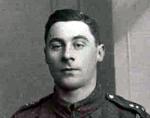
Fred Middleton close-up
He had previously been in the South Staffordshire Regiment. The Lancashire Fusiliers were part of 29th Division who went into action five miles east of Hazebrouck on 12th April 1918. This was in response to a massive German offensive known as Georgette which struck the British army around Ypres and was a follow up to the successful offensive further south which begun on 21st March 1918 and ground to a halt outside Amiens at the end of April. The Germans were stopped outside Hazebrouck but Shockie was killed and his body never recovered.
![Herbert Seamarks [P71/28/14/9]](/CommunityHistories/Stevington/StevingtonImages/Herbert Seamarks [P71-28-14-9].jpg)
Herbert Seamarks [P71/28/14/9]
SEAMARKS, 15084, Sergeant Herbert: 1st Battalion, Bedfordshire Regiment. He was the son of Ellen Purser (formerly Seamarks} of Radwell, Felmersham, but he had been born in Stevington. He was killed in action on 28th September 1918 and is commemorated on the Vis-en-Artois Memorial.
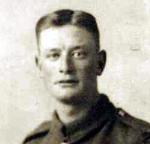
Herbert Seamarks close-up
The war diary for 27th September reads: "Battalion advanced over the top to the attack at 7.52 a.m. & captured part of BeaucampsVillage, all objectives taken. During the afternoon German Bombing Party attacked which caused Battalion to draw back to Sunken Road & evacuate the village. Capt H. C. Loe, M. C. & 2/Lt. H. Hutchinson Killed. Capt. R. L. Shaw, Capt & Adjt. A. H. O. Riddell, Lt. F. H. Melvill & 2/Lts. W. T. Morris, J. T. Laughton, G. W. Blackwell Wounded. Other Ranks - 19 Killed, 96 Wounded, 1 Died of Wds. 19 Missing & 1 Wd. & Missing". The diary for 28th reads: "Germans evacuated BEAUCAMP [sic]. Cheshires & Norfolks advanced with Bedfords & Warwicks in support. Lt. C. G. Watkins, W[ounde]d. at duty. O [ther] R[anks] - 1 Killed & 3 Wounded". Thus it seems that poor Private Seamarks was the only man killed that day. His body was never recovered.
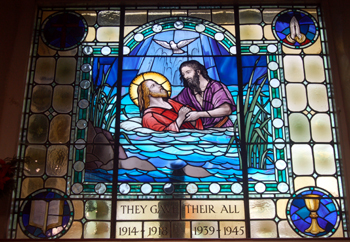
Stained glass war memorial window in West End Baptist Meeting December 2009